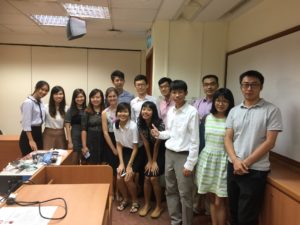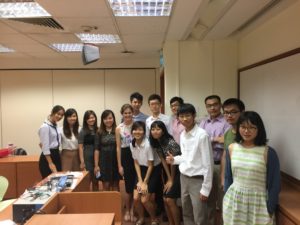BN3101: Biomedical Engineering Design
Module Description :
Preparation of formal engineering reports on a series of engineering analysis and design problems illustrating methodology from various branches of applied mechanics as applied to bioengineering problems. Statistical analysis. A term project and oral presentation are required. Students are exposed to the entire design process: design problem definition, generation of a design specification, documentation, design review process, prototype fabrication, testing and calibration.
Note: Lecture to be conducted online. Students need to go through the lecture notes each week before attending tutorials.
Schedule & Tutorials
wk1: Background and clinical descriptions
Tutorial: Background introduction slides (HandExoskeletonIntro.pdf)
A pre-recorded video tutorial for the project introduction:
Selected videos (a playlist of video series):
In-house soft robotic hand
Reference in-house manipulators
- Tendon-driven Flexible Manipulator
- A compact continuum tubular robotic system for transnasal procedures
- Body-Attached Soft Robot for Ultrasound Imaging
wk2: Intellectual Property
Tutorial Agenda:
– Literature review slides – wk2-IP-Literature Review Of Biomimetic Wire-Driven Mechanisms for Swimming/Flying/Medicine (.pdf)
– Present the rough idea of your design concepts
– Do patent search, present &
Follow up actions:
- Search for 10 most relevant patents for your projects
- Generate keywords using these patents pertaining to your projects
- Generate a list of User specifications for your device using this list of 10 related patents. Hint: look for the various features of patented devices, and appreciate the intention of these features
- Create a table to compare the 10 patented devices’ features
- discuss/present the 3 (1 patent for every 2 members) most related ones for each group
References:
– You may search patents from www.google.com/patents or www.uspto.gov
– Patents filed by other groups (deflectable catheter US2013296781A1) | (arthroscope US2007179340A1 )
– Provisional patents filed to ILO by my research group FYI: (soft endoscopic robot) | (cable-driven flexible manipulator)
– How to tell if a patent has expired? It turns out not obvious and please refer to the following readings: Brown & Michaels – “How To Determine Patent Term” USPTO:Patent Term Calculator (Beta Version) Has a patent expired? – Part I
FYI only: Flipped class lectures:
– Week 2 breeze video lecture about IP study: https://breeze.nus.edu.sg/ip1
wk3: Design Methodology and Design Analysis
Tutorial Agenda (with tutors):
Follow the Design Methodology Slides and briefly identify:
– Role of each team member
– Procedure
– Project Plan Schedule
– Rough Needs‐Metrics Matrix
FYI only: Deprecated Flipped class lectures:
– Design Methodology Slides by Prof Leo & Prof Chan: Design Methodology in Bioengineering
– Associated breeze video lecture (also accessible through IVLE): https://breeze.nus.edu.sg/p4ktu5izooe/
wk4: Risk Analysis, Design Rationale and Verification
Tutorial Agenda:
– Follow up with week-2 action items and progress update
– Follow the above slides in Design Rationale, Design Verification, and Risk Analysis, briefly/roughly identify:
– How to address “Anatomical Variations” issue
– How to address “User Needs, Product Scope, and Design Acceptance Criteria”
– Failure Mode, Cause of Failure, and Harms associated with your products
FYI only: Deprecated Flipped class lectures:
–Risk Analysis Table[.docx]
–Design Rationale and Design Verification 2014[.pdf] breeze lecture (https://breeze.nus.edu.sg/p6obwzld267/)
–Risk Management [.pdf]
wk5: Recap IP, Design Justifications, ASTM Assignments
Reference:
– F1218 – 89(2014) : Standard Specification for Bronchoscopes (Rigid)
– F2726 – 08: Standard specification for fixation devices for tracheal tubes and other airway devices
– ASTM F1992 – 99(2007) Standard Practice for Reprocessing of Reusable, Heat Stable Endoscopic Accessory Instruments (EAI) Used with Flexible Endoscopes
–ASTM F1518 – 00 Standard Practice for Cleaning and Disinfection of Flexible Fiberoptic and Video Endoscopes Used in the Examination of the Hollow Viscera (Withdrawn 2009)
– Rebuttal documents by my research group FYI: (cable-driven flexible manipulator )
wk6: ASTM presentation
Tutorial
Reference News: the hand grasp testing will have international standard – check out here, which will be excellent references for you to set up your experiments after you have the prototype : http://www.nist.gov/el/isd/grasp.cfm
wk7: Mid-term Review
Dr. Ren: Presentation by Groups
– Presentation: 20 minutes for each group (15 presentation +5 QA)
– An extended/refined/polished/justified wrap-ups for the work done in the past 6 weeks, including introduction/background/clinical needs/markets/significance/SOA/gaps-to-fill; IP, design methodology/design analysis/rationale/verification; risk analysis; regulatory; prototyping;envisioned procedures/system etc.
wk8: Sterility Requirements & GLP
– Reference: Highly Biomimetic Design of a Muscle Glove (pdf from a RAL/ICRA 2016 submission 16-0311_01_ms)
wk9: Bioethics, Quiz, & Individual Project Update
Flipped online class: Bioethics (Bioethics and Medical Device.pdf)
Quiz: 1) 50 MCQs; 2) Duration is 1 hour, from 11am; 3) Quiz comprises of MCQs questions from weekly online assessments, and some new MCQs; 4) Closed-Book quiz
Tutorial: Motorization (slides: MotorControl-Tutorial.pdf) & modeling (slides: tendon-driven-manipulator-kinematics.pdf).
wk10: Final Dry Run with Project Supervisors
wk11: Free Day for Team to Fix any problem with prototype
wk12: Final Oral Presentation of Project
wk13: Submit prototype, reports and final project documents to project supervisor by 5 pm
Please submit soft copy of your report & project data and actual prototype to your respective supervisor. That is:
-
Physically: submit project prototype (including tools borrowed, make also sure the prototype is functional at the time of your submission.) to Dr. Ren
-
Electronically: (dropbox/google-drive or whatever ways preferred) submit to Dr. Ren your group-project development documents including:
-
– reports in .docx format
-
– project presentation files (ASTM and final) in .pptx or equivalents (please make sure the video(s) is playable in another PC if applicable);
-
– CAD design files (in solidworks or equivalents)
-
– if applicable, source codes and a readme file on how to run the code
-
– other key project data (e.g., verification experiment data collected in .xlxs), references including ASTM standards, patents cited, and reference papers, etc.
-
-
The reports shall have maximum 30 pages based on the template. With justifications, you may keep main critical content within 30 pages and refer other non-critical contents, such as references as appendix or dropbox documents.
- Two patent files you need to prepare to NUSRI: sample disclosure form.doc (Just put your personal inf) ; sample patent(Have to be in Chinese).docx (focus on key claims);
- (Optional) After your exams, you are encouraged to revise your report as a manuscript to IJRA or MBEC
- Reference only: Provisional patents filed to ILO by my research group FYI: (soft endoscopic robot) | (cable-driven flexible manipulator)
Further possibilities
Possibility of investing your project and extend it to competitions (Completely voluntary and please discuss with Dr. Ren if for possible further extensions/supports/funding):
- A manuscript to IJRA or MBEC
- Samsung Solve For Tomorrow Competition http://www.samsung.com/sg/solvefortomorrow/
- The Design of Medical Devices Conference call for 2-page technical brief (by Nov. 9, pretty easy to get accepted and it can be just a summary of your group project). You only need to follow “the required Technical Brief Template (Word)” (2-page) and get my comments before submission. The benefit is that “All accepted papers will be published as a two-page Technical Brief in the June and September issues of ASME Journal of Medical Devices” after giving the conference presentations and this would be a pretty good record in your CV when you are looking for jobs.
Open source robotic hand projects
- http://www.openbionics.org
- http://www.eng.yale.edu/grablab/openhand/
- http://www.openhandproject.org/
- http://softroboticstoolkit.com/
- https://en.wikipedia.org/wiki/Open-source_robotics
More information
- http://www.biodsign.org
- BN3101 2009/2010, Semester 1
- BN3101 2010/2011, Semester 1
- BN3101 2011/2012, Semester 1
- More Information can be found from IVLE – Integrated Virtual Learning Environment
- Tips for literature review
- Interdisciplinary development of a Single-Port Robot (TUM Robio2012 Best paper)
- A brief tutorial about motor control: (MotorControl.pdf)
- Good review articles about flexible manipulators (poster picture) ( article from the ACMIT partner Delft Bio-Mech group on the systematic categorization of steerable tools) (source)




